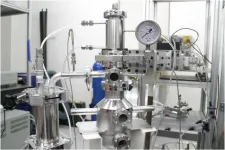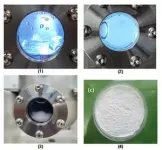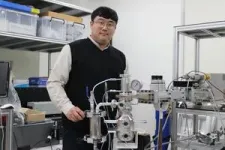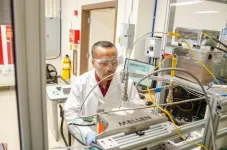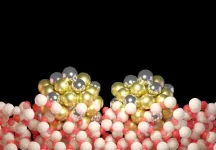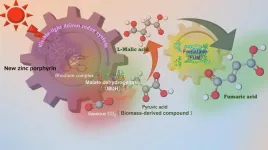(Press-News.org) New research suggesting a improved method for extracting lithium by applying plasma technology has been recently published.
On the 31st of January, the Korea Institute of Fusion Energy(KFE) announced revealed that their researchers have successfully increased the lithium extraction rate by three times compared to pre-existing methods by applying CO2 microwave plasma technology.
The most common method of extracting lithium is mixing sodium carbonate(Na2CO3) to saltwater that contains lithium and extracting lithium carbonate(Li2CO3)-which is a mixture of lithium and carbon dioxide. The downside to this method is that it requires an additional process to separate the lithium carbonate from sodium impurities that blend together during the extraction process.
There exists an alternative method in which carbon dioxide gas is used instead of sodium carbonate. However, the issue with this method is that extraction rates are low in brine where lithium salt-a bond between lithium and chlorine- exists. Research is required to address this issue.
Dr. Ji Hun Kim and Dr. Jong keun Yang of the KFE utilized carbon dioxide microwave plasma technology-which involves ionizing carbon dioxide into a plasma state-to increase the rate of lithium extraction.
Researchers at KFE conducted experiments to compare carbon dioxide plasma lithium extraction and pre-existing methods of lithium extraction utilizing simulated brine. The research showed using plasma technology increased extraction rates by around 3 times.
While direct injections of carbon dioxide gas netted 10.3% lithium extraction rates, in experiments using carbon dioxide plasma the lithium extraction rate reached 27.87%.
This is the first research that demonstrated an increase in lithium extraction rates by applying plasma technology to the lithium extraction process. The paper was published* in DESALINATION (IF 9.9)-an authoritative academic publication in the field of water resources.
*Novel approach for recovering lithium from simulated aqueous solutions using carbon dioxide microwave plasma (December, 2023)
Dr. Yang, who is the first author of the research paper, remarked that “It was possible to confirm the effects of the heat and ions, electrons, radicals etc that are generated when carbon dioxide plasma forms on lithium extraction rates” and continued that “We plan to expand research into plasma lithium extraction processes through additional research into carbon dioxide plasma reactions.”
Researchers are hopeful that lithium extraction processes using plasma can be a novel approach for developing technology that can more efficiently extract lithium from seawater with lower concentrations of lithium.
President Suk Jae Yoo of KFE remarked that “This research shows a new possible use for plasma technology, which has been used extensively in cutting-edge fields such as semiconductors.” Further, President Yoo remarked “Lithium obtained from seawater is a crucial component of fusion energy generation, and we will continue to conduct research into both fusion energy development and fusion energy fuel acquisition.”
###
The Korea Institute of Fusion Energy(KFE) is Korea's only research institute specializing in nuclear fusion. Based on our development and operation of KSTAR, a superconducting fusion research device, the KFE seeks to achieve groundbreaking research results, develop core technology for commercializing nuclear fusion, and train outstanding nuclear fusion personnel. In addition, the institute is spearheading a joint effort to open the era of nuclear fusion energy in the mid-21st century through active participation in the ITER Project.
The KFE is leading the way in securing safe energy sources through nuclear fusion energy development as well as developing plasma-based technologies for a comfortable and clean environment. We are striving to achieve research results that benefit a wider public by developing plasma technologies applicable not only in high-tech industries but also in the environment and agricultural sectors.
END
Plasma technology for more effective lithium extraction
Applying plasma technology increases efficiency by 3-fold. Confirmation of a novel approach for lithium extraction from brine
2024-02-16
ELSE PRESS RELEASES FROM THIS DATE:
Can astronomers use radar to spot a cataclysmic asteroid?
2024-02-16
How can humans protect the Earth from “devastating asteroid and comet impacts?” According to the National Academies and their 2023-2032 Planetary Science and Astrobiology Decadal Survey, ground based astronomical radar systems will have a “unique role” to play in planetary defense.
There is currently only one system in the world concentrating on these efforts, NASA’s Goldstone Solar System Radar, part of the Deep Space Network (DSN). However, a new instrument concept from the National Radio Astronomy Observatory ...
Self-monitoring improves physical activity of care-needing elderly
2024-02-16
Self-monitoring of physical activity with an accelerometer and feedback is an effective tool to improve physical activity in elderly people requiring long-term support. The Kobe University study is the first to show that with simple and safe means the physical activity of this demographic can be improved, which is expected to help prevent serious illness and reduce costs for long-term care.
Taking more steps and sitting less is well known as having a significant influence on a wide range of noncommunicable diseases such as heart disease, diabetes, orthopedic diseases and stroke. This is particularly problematic in senior citizens who depend on long-term care such as in day-care ...
WVU close to commercializing microwave technology that can cool down industry’s energy usage
2024-02-16
West Virginia University engineers have secured $3 million in U.S. Department of Energy funding to research a new chemical reactor system that uses microwaves to reduce industrial heat and carbon emissions.
The first-of-its-kind technology would allow industrial facilities to simultaneously produce ethylene and ammonia, two chemicals that contribute significantly to greenhouse gas emissions, within a single microwave reactor. That device uses heat from microwave electromagnetic radiation to carry out chemical reactions.
The ...
New Issue of GEN Biotechnology
2024-02-16
GEN Biotechnology announces the publication of its February 2024 issue. GEN Biotechnology publishes outstanding peer-reviewed research and perspectives in all aspects of biotechnology. The Journal, led by Editor-in-Chief Hana El-Samad, PhD (UCSF; Altos Labs) and Executive Editor Kevin Davies, PhD, is published bimonthly in print and online.
For full-text copies of articles or to arrange interviews with Dr. El-Samad, Dr. Davies, authors, or members of the editorial board, contact Kathryn Ryan at the Publisher.
1. Original Research: ...
New chip opens door to AI computing at light speed
2024-02-16
Penn Engineers have developed a new chip that uses light waves, rather than electricity, to perform the complex math essential to training AI. The chip has the potential to radically accelerate the processing speed of computers while also reducing their energy consumption.
The silicon-photonic (SiPh) chip’s design is the first to bring together Benjamin Franklin Medal Laureate and H. Nedwill Ramsey Professor Nader Engheta’s pioneering research in manipulating materials at the nanoscale to perform mathematical computations using light ...
Study shows impact of antidepressants on fetal brain development during pregnancy
2024-02-16
A new study published in Nature Communications provides direct evidence that antidepressant use during pregnancy can impact a child’s brain development and contribute to the risk of mental health disorders later in life.
The study, led by researchers at the University of Colorado Anschutz Medical Campus, focused on the effect of fluoxetine, commonly used in medications such as Prozac and Sarafem for treating depression and perinatal depression, on a developing prefrontal cortex.
Since fluoxetine works by increasing the levels of serotonin in the brain, the researchers looked at the impact serotonin has on prefrontal ...
First human trial shows ‘wonder’ material can be developed safely
2024-02-16
A revolutionary nanomaterial with huge potential to tackle multiple global challenges could be developed further without acute risk to human health, research suggests.
Carefully controlled inhalation of a specific type of graphene – the world’s thinnest, super strong and super flexible material – has no short-term adverse effects on lung or cardiovascular function, the study shows.
The first controlled exposure clinical trial in people was carried out using thin, ultra-pure ...
Towards more efficient catalysts
2024-02-16
Researchers from the Harvard John A. Paulson School of Engineering and Applied Sciences (SEAS), Harvard Department of Chemistry & Chemical Biology, and Utrecht University have reported on a previously elusive way to improve the selectivity of catalytic reactions, adding a new method of increasing the efficacy of catalysts for a potentially wide range of applications in various industries including pharmaceuticals, cosmetics and much more.
The research is published in ...
Laboratory study on conditions for spontaneous excitation of "chorus emission," wave of space plasma
2024-02-16
A dipole magnetic field, created by a ring current, is the most fundamental type of magnetic field that is found both in laboratories and in space. Planetary magnetospheres, such as Jupiter's, effectively confine plasma. The RT-1 project aims to learn from nature and create a magnetosphere-type high-performance plasma to realize advanced fusion energy. Simultaneously, the artificial magnetosphere offers a means to experimentally understand the mechanisms of natural phenomena in a simplified and controlled ...
Advanced artificial photosynthesis catalyst uses CO2 more efficiently to create biodegradable plastics
2024-02-16
Amid growing global concern over climate change and plastic pollution, researchers at Osaka Metropolitan University are making great strides in the sustainable production of fumaric acid – a component of biodegradable plastics such as polybutylene succinate, which is commonly used for food packaging. The researchers have managed to efficiently produce fumaric acid, which is traditionally derived from petroleum, using renewable resources, carbon dioxide, and biomass-derived compounds.
In a previous study, a research team led by Professor Yutaka Amao of the Research Center for Artificial Photosynthesis at ...
LAST 30 PRESS RELEASES:
New research by ASU paleoanthropologists gives valuable insight into how two ancient human ancestors coexisted in the same area
Therapeutic use of cannabis and cannabinoids
‘Cognitive Legos’ help the brain build complex behaviors
From inhibition to destruction – kinase drugs found to trigger protein degradation
Diamond defects, now in pairs, reveal hidden fluctuations in the quantum world
Metastatic recurrence among adolescents and young adults with cancer
Disrupted federal funding for extramural cancer research
Glucagon-like peptide-1 receptor agonists and chronic cough
The 2025 Los Angeles wildfires and outpatient acute health care utilization
Why watching someone get hurt on screen makes you wince
Data-driven surgical supply lists can reduce hospital cost and waste
Plants use engineering principles to push through hard soil
Global burden and mortality of amyotrophic lateral sclerosis and other motor neuron diseases in 204 countries and territories, 1990–2021
Research into zoonotic disease risks requires a One Health approach
The seamounts of Cape Verde: a biodiversity hotspot and a priority for marine conservation in the central-eastern Atlantic
Scientists uncover how a mitochondrial mutation rewires immune function
Do children imitate communication manners of machines? Experiment on children's response to polite vs. commanding robot
Tiny traps, big trouble: Small regions within cells aggregate proteins linked to ALS, dementia
The future of type 1 diabetes: Can stem cells provide a cure?
UBC researchers uncover how statins harm muscles—and how to stop it
SwRI tackles pre-ignition challenges in hydrogen-fueled engines
Making LAZY plants stand up: Research reveals new pathway plants use to detect gravity
HBNU researchers propose novel sensor-integrated wrapper for food quality monitoring and preservation
Role of ubiquilin-2 liquid droplets in α-synuclein aggregation
Hanyang University researchers proposed novel technology for environmental infringement and sag estimation for transmission lines
Pro fighters risk damage to the brain’s ‘garbage disposal’
AI tops density in predicting breast cancer risk
Pesticides and other common chemical pollutants are toxic to our ‘good’ gut bacteria
Chemists design OLEDs that electrically flip the handedness of light
Experimental mRNA therapy shows potential to combat antibiotic-resistant infections
[Press-News.org] Plasma technology for more effective lithium extractionApplying plasma technology increases efficiency by 3-fold. Confirmation of a novel approach for lithium extraction from brine
